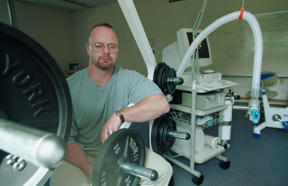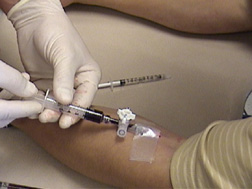|
High Carbs for Everyone? Part I: Carb Nightmare? by Lonnie Lowery, PhD Cndt, Feb 2001 |
|
You see it first! Some pretty disturbing EARLY data revealing the struggle your body undertakes just to deal with dietary carbohydrates while in a sore state. You punish your body with intense exercise but you're certainly no runner. The bottom line is, you shouldn't have to rely on high carb recommendations that stem from research on endurance athletes! Well, you don't have to anymore...
 Do you get muscle soreness regularly from your lifting? If you train intensely, using eccentric contractions ("negatives") you're probably no stranger to the pain that comes from muscle damage. By "muscle damage" we mean the microscopic trauma that causes weakness and soreness while your body struggles to recover. Experienced lifters and physiologists know that the actual time spent in the gym is destructive, not constructive; that is, maximal growth comes only after some stress is placed upon a muscle and some damage is done. But many do not realize that if a large enough amount of muscle tissue is stressed, their ability to take-up and metabolize blood glucose is considerably worsened. That's right. Worsened.
 A disease that is similar to (but more severe than) this state of poor glucose tolerance is Type II diabetes. Type II diabetics suffer from bodily tissues that are chronically unresponsive to insulin. The carbohydrates they eat enter their bloodstream (as glucose) but tend to stay there, gumming-up (glycosylating) other blood constituents and casing the pancreas to dump insulin in an effort to drive it in. About 90% of them are obese and have other problems related to hyperinsulinemia. Although many bodybuilders actually use insulin injections to aid muscle growth and recovery (dangerous and not recommended!), Type II diabetes is definitely "too much of a good thing". You see, having excess insulin in one's circulation can cause a number of problems, not the least of which is excess body FAT.
 Enter exercise. It's a great way to get muscles to take-up blood glucose independent of insulin. Endurance training and weight training are a critical part of American Diabetes Association guidelines. But spending 30 minutes on a universal machine lifting two plates is a far cry from having 315 on one's back for six sets of ten! This is one thing we've been discovering lately in the Human Nutrition Lab (HNL) at Kent State University. Place enough load on large muscle groups using negatives - as many athletes do - and glucose intolerance can result! It's not as severe as that seen in diabetics but it appears to be enough to dampen recovery. You see, muscles need to turn blood glucose into glycogen (stored carbs) to stay full and energetic... but it can't get into a damaged muscle very well. It's a "catch-22" situation. Eccentric contractions induce superior growth4 but result in long recovery periods and poor carbohydrate efficiency.(Ref 1,2,3,6,7) With regards to glucose intolerance, it's a scenario similar in appearance to Syndrome X, a condition rampant in western societies characterized by obesity and hypertension - presumably due to poor glucose handling. Even without intense lifting nearly 10% of men are hyperglycemic (have abnormally high blood glucose) (5). Taking a look at data that's hot off the presses from the HNL at Kent State, we see that early results suggest hampered glucose tolerance in all subjects from muscle damage. This bodes poorly for maximal recovery. The lines come from an oral glucose tolerance test (OGTT) performed before and 24 hours after an intense workout. An OGTT is simply a series of blood draws, taken before and immediately after ingestion of 75 g of glucose (fast-acting sugar). Blood glucose commonly goes up about 40 points (mg/ dl) between 30-60 minutes, then insulin drives it back down. We didn't expect blood glucose to be this affected by the intense (eccentric) lifting. You see, the body's control over circulating glucose is necessarily TIGHT. We hypothesized (guessed) that subjects' pancreases would have to dump extra insulin to keep the glucose down in the face of all this "trauma", but not this actual hyperglycemic response; wow! The exercise bout consisted of six sets of six repetitions at 80% of the subjects' one rep max. Both bench press and squatting were performed in this manner on a Smith machine, using a four-count to lower the bar. The exercise session was designed to affect a maximal amount of skeletal muscle but also to mimic a state that is common to weight lifters.
 Of course data is still coming in, but we are able to share some numbers on the first five subjects. By analyzing the data, we find that (with a fancy statistical test) we have high statistical power, meaning that we will end up with significant results by the end of the study (20 subjects). Yes, stats can turn us into veritable "swamis", allowing us to "see into the future" and not waste time on worthless studies. How many supplement investigators do that?! It's another benefit of having strong researchers at the HNL. We've got evidence to be pretty excited about the possibility of actually changing current nutrition recommendations for lifters, which is why I'm sharing this info now. I have to reserve final judgment, however, for the date my associates and I complete the study. It's also important to realize that we need to validate that the large muscle groups of the shoulder girdle and lower body were actually damaged to some extent from the exercise. To do this we took some of the blood from the OGTT, spun it down in a centrifuge and tested the serum for creatine kinase (CK), alanine aminotransferase (ALT), aspartate aminotransferase (AST) and lactate dehydrogenase (LDH). These enzymes (notice the -ase suffix on each word; that denotes an enzyme) are "spilled" from muscle tissue for a period of 3-7 days after hard eccentric exercise.(6) They suggest muscle trauma and our subjects were, in fact "traumatized". The relatedness (or correlation) between fasting blood glucose and CK, for example, was tested on two separate post-workout occasions, revealing significant relationships (r = 0.54 to 0.75). These are moderate to strong relationships between muscle damage and poor glucose usage. In other words, when muscles are damaged, dietary carbs don't leave the blood stream very well (and enter the muscle tissue). Muscle soreness measurements add to the evidence, also suggesting that damage was done (have YOU ever gotten really sore from training?). They correlated moderately to highly with the CK results. Clearly runners and cyclists need to replenish carb stores; they exhaust their glycogen almost daily. Hence the high dietary carb recommendations. And although many weight trainers insist carbs make them fat, they do need some for similar reasons. But for most of us it's really about growth as opposed to say, boosted performance and if we're not getting them into our sore muscles, where are they going? One answer could be adipose tissue. Yep, body fat is another recipient of blood glucose. When insulin levels are high, fat cells grab up the blood borne glucose - even more so than sore muscles, presumably. And what happens to glucose once in a fat cell? You guessed it, fat building (lipogenesis). So now we see a "double whammy" scenario when muscles are just too rocked to accept blood glucose efficiently: First, they can't recovery rapidly, failing to optimally replenish their glycogen stores (and creating muscle fullness); Second, the left over circulating glucose likely goes where it can, into body fat. What can be done about this problem that appears to be specific to weight trainers? Well, one thing is to report it to the scientific community so "experts" tone-down their "high carbs for all athletes" recommendations. Another is to give some preliminary suggestions to athletes as to when to eat plenty of carbs and when it might be better to reduce them. Finally, we can search for nutrients that may help glucose tolerance so bodybuilders can continue to induce muscle growth via "negatives" AND recover maximally. THAT, my friends, is what we're working on in the HNL right now! Stay tuned for Part Two of "High Carbs for Everyone?" to get practical suggestions and to see which compounds we're testing and what they're doing for glucose metabolism! Editors' Note: Remember, data are preliminary, using available data as it comes-in and representative case examples. It's important to wait for the completion of these studies for more comprehensive conclusions. www.VirtualMuscle.com and www.GetBig.com share this information in an effort to get it to those who matter, the ATHLETES, as soon as possible! For more information contact robertfortney@hotmail.com.
REFERENCES
1. Doyle, J., et al. (1993). J Appl Physiol 74(4): 1848-1855.
|